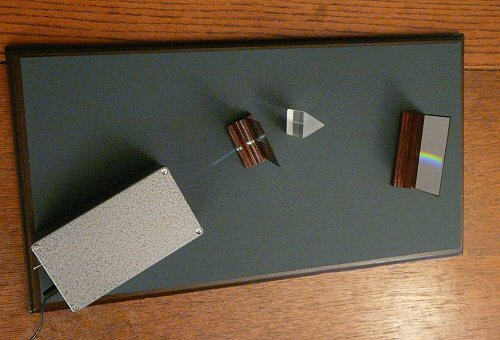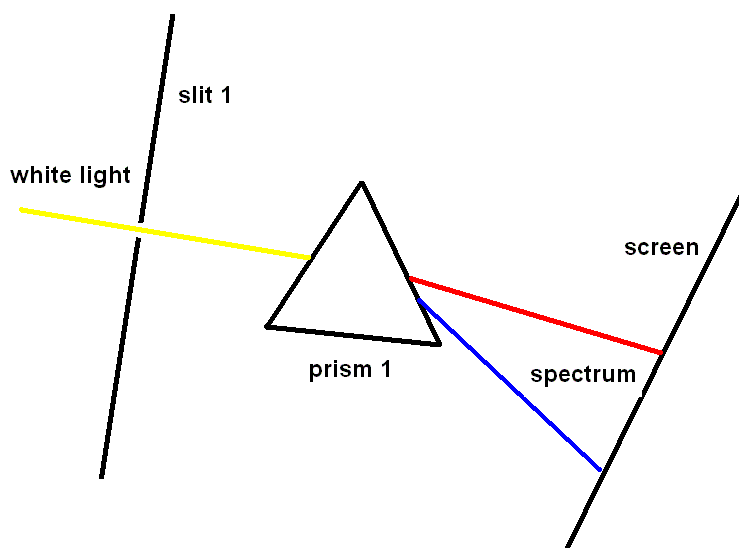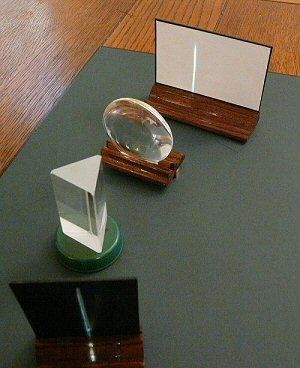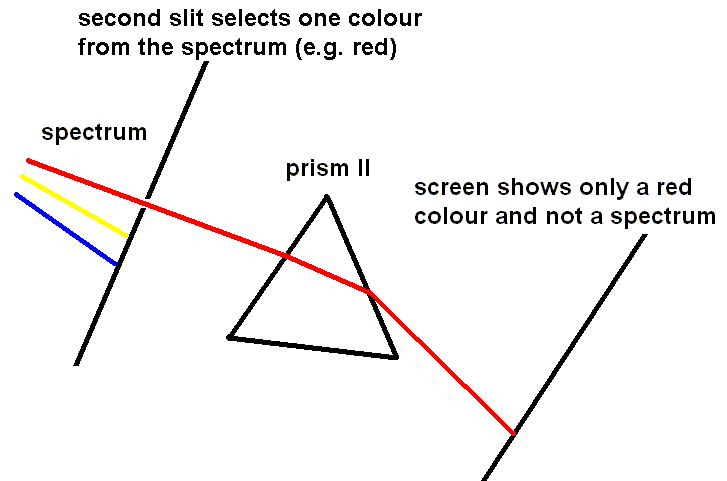Newtons Experiments - light and prisms
This is Newtons famous experiment where a triangular prism is used to 'split' white light into the colours of the spectrum. In this apparatus we have a mains powered light box to create parallel white light beams, two prisms, various slits to help collimate the beams as well as small white projection screens. A solid wooden base is provided so that everything can be easily aligned correctly.

Experiment 1
We set up the light box (left hand side of above photo) to produce a slit of white light that will fall on the prism and about 15 cm away. In between the two set up a slit to make sure that the light is as collimated as possible. 15 cm or so away from the prism on the other side of the table set up a screen. Adjust (rotate) the prism until a spectrum of colours can be seen on the screen. You may need to dim the room lighting so that it is clearly visable.
You can move the slit closer to the prism to improve the colour seperation. The light from the light box should be composed of white rays all in parallel, but in practice there will be some spread of angles coming from the box. If these unparallel rays go into the prism they will each create a spectrum of their own and cause a jumbling of colours and so spoil the show. With the slit moved near to the prism it reduces the spread of rays so they are all nearly parallel - it makes a lot of difference to the spectrum projected on the screen but we do lose a little light in the process and so the spectrum is not quite so bright.


The white light composed of many colours is going into the prism. Every colour will be bent (refracted) slightly differently by the materail properties of the glass. Red light is bent least while the blue colours are bent greatest. As a result white light going in to the prism on one side emerges as a refracted spectrum of colours.
I used a powerful (2W) white LED in the light box. This is not a truly multicoloured white light source like the rays from the Sun for example. As a result the spectrum is not quite so perfect as you would see produced by small rain drops in the wonderful display of a rainbow.
The prism orintation makes a lot of difference to the quality of the spectrum. The angle between the light rays coming in and the spectrum coming out of the prism can be seen on the photo above and in practice adjust this for the best spectrum.

Experiment 2
Leaving the apparatus setup as in Experiment 1 move the screen slightly further away to say 25 cm or so. Now midway between the prism and the screen insert the lens. The lens will recombine the spectrum projecting a white light band / slit onto the screen. These experiments therefore show that white light can be split into the spectrum but also that the spectrum can be reassembled into white light again !

Experiment 3
During Newtons time there was some sceptism about what was precisely going on with the white light and the prism glass. Some thought that the spectrum was directly produced by the glass rather than a seperation of colours brought about by the different degrees of angle deflection (refraction). So Newton devised this simple experiment (called 'Newton's Experimentum Crucis') to prove the case.
Set up as in Experiment 2 and introduce a second slit, second prism in place of the lens. By adjusting the second slit one can chose a colour from the spectrum produced by the first prism (lets say the red light) and send this through the second prism. We dont see another spectrum being produced from this red ray, instead we just see the red ray being refracted by the second prism. We can do this for any other colour showing that the spectrum is not produced by some 'colouration' effect by the passage of the rays through the glass prism.

back to Newton page
Dr Jonathan Hare, E-mail: jphcreativescience@gmail.com
NOTE: Although none of the experiments shown in this site represent a great hazard, neither the Creative Science Centre,
Jonathan Hare nor The University of Sussex can take responsiblity for your own experiments based on these web pages.
THE CREATIVE SCIENCE CENTRE
home | diary | whats on | CSC summary | latest news






